
White Castle Building Number 8 is a former White Castle restaurant building in Minneapolis, Minnesota, United States. It was one of the few prefabricated, portable buildings built by the chain, and is now the headquarters of Minnesota nonprofit, Diverse Emerging Music Organization (DEMO), whose purpose is "to archive and preserve every independent and small commercial recording released by Minnesota musicians."
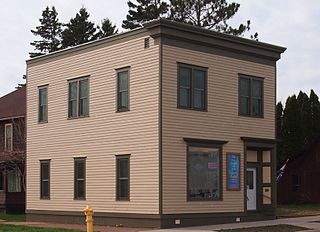
The John Dwan Office Building, located at 201 Waterfront Drive in Two Harbors, Minnesota, in the United States, is a historical building and now a museum for 3M.

The Wedgwood Institute is a large red-brick building that stands in Queen Street, in the town of Burslem, Stoke-on-Trent, Staffordshire, England. It is sometimes called the Wedgwood Memorial Institute, but it is not to be confused with the former Wedgwood Memorial College in Barlaston. It achieved listed building status in 1972.
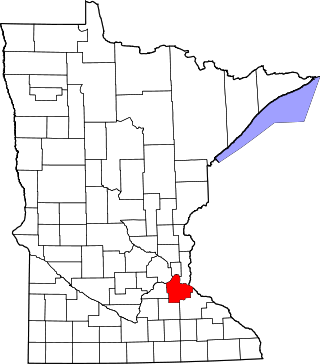
This is a list of the National Register of Historic Places listings in Dakota County, Minnesota. It is intended to be a complete list of the properties and districts on the National Register of Historic Places in Dakota County, Minnesota, United States. Dakota County is located in the southeastern part of the U.S. state of Minnesota, bounded on the northeast side by the Upper Mississippi River and on the northwest by the Minnesota River. The locations of National Register properties and districts for which the latitude and longitude coordinates are included below, may be seen in an online map.
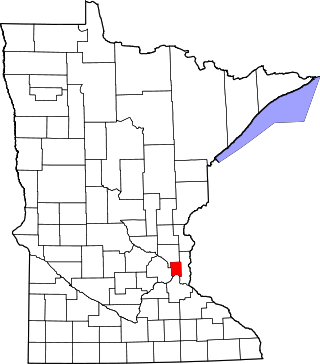
This is a complete list of National Register of Historic Places listings in Ramsey County, Minnesota. It is intended to be a complete list of the properties and districts on the National Register of Historic Places in Ramsey County, Minnesota, United States. The locations of National Register properties and districts for which the latitude and longitude coordinates are included below, may be seen in an online map.

The Walsh Building in Saint Paul, Minnesota, United States, was designed by Edward Bassford in 1888. The Romanesque Revival building has been used as a residence, school, and manufacturing facility. It is listed on the National Register of Historic Places.

Merchants National Bank is a bank building in Winona, Minnesota, United States, designed in the Prairie School architectural style. It was built in 1912 and features elaborate terracotta and stained-glass ornamentation. It was listed on the National Register of Historic Places in 1974 for having state-level significance in the themes of architecture and commerce. It was nominated for being the "largest and probably best example" of the 18 Midwestern banks designed by Purcell, Feick & Elmslie, a significant influence on early-20th-century American architecture. It is also a contributing property to the Winona Commercial Historic District.

The Graybar Electric Company Building is located at 55 West Canfield Street in Midtown Detroit, Michigan. This warehouse building was rented to the Graybar Electric Company from 1926 into the 1940s. It was listed on the National Register of Historic Places in 1997.

The Benjamin Stickney Cable Memorial Hospital is a historic hospital building at the junction of Massachusetts routes 1A and 133 in Ipswich, Massachusetts, U.S. The Colonial Revival building was built in 1917, following an extended fundraising effort, begun in 1906 and pushed further along by philanthropist and Castle Hill owner Richard T. Crane, Jr., after the 1915 death in a car accident of his friend, Benjamin Stickney Cable. Crane purchased the land on which the building sits and made a further donation of $145,000 to the construction fund.
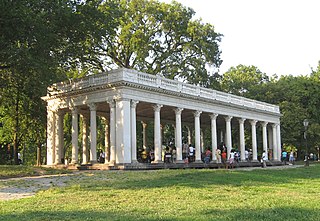
The Grecian Shelter, designated a Croquet Shelter on the original plans of Prospect Park, is also referred to as the Prospect Park Peristyle or Peristyle. The building, a peristyle with Corinthian columns, is situated near the southern edge of Prospect Park in Brooklyn, New York. Constructed by McKim, Mead and White in 1905, this peristyle was built on the site of the 1860s-era Promenade Drive Shelter along the southwest shore of the Prospect Park Lake. The Prospect Park Peristyle is designed in the Renaissance architectural style. It consists of a raised platform located two steps above ground level; the platform is covered by a rectangular colonnade with 28 Corinthian marble columns, each with square piers. An entablature of terracotta runs atop the structure. The building was constructed as a temporary refuge from rain and sun.

The Freeland Street School, now the University Park Campus School, is a historic school at 12 Freeland Street in Worcester, Massachusetts. It is a 2+1⁄2-story brick building built in 1885 during a period of significant growth in the city. The front and back of the building have slightly projecting gabled sections that house the buildings entries and stairwells. The exterior of the building is trimmed in sandstone, with some decorative terracotta panels. The roof his hipped, and the projecting sections are flanked by small hip-roofed dormers.
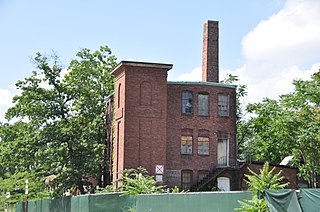
The O'Hara Waltham Dial factory was a historic building at 74 Rumford Avenue in Waltham, Massachusetts. The three story brick structure was built in 1897 by Daniel O'Hara, and housed his company, a spinoff from the Waltham Watch Company which specialized in the manufacture of a variety of clock faces. The building had distinctive corner towers with paneled brick surfaces, although these were a later addition. O'Hara's company operated until the late 1950s; the facility was then used in the manufacture of traffic signals and luggage.

The Corbin Building is a historic office building at the northeast corner of John Street and Broadway in the Financial District of Manhattan in New York City. It was built in 1888–1889 as a speculative development and was designed by Francis H. Kimball in the Romanesque Revival style with French Gothic detailing. The building was named for Austin Corbin, a president of the Long Island Rail Road who also founded several banks.

The Linograph Company Building, also known as the Englehart Manufacturing Company Building and RiverWalk Lofts , is a historic building located in downtown Davenport, Iowa, United States. It was listed on the Davenport Register of Historic Properties and on the National Register of Historic Places in 2009.

The Lee County Courthouse, also known as the South Lee County Courthouse and the U.S. Post Office and Courthouse, is a historic building located in Keokuk, Iowa, United States.

The Westerman Lumber Office and House is a historic building in Montgomery, Minnesota, United States. The private, commercial structure was placed on the National Register of Historic Places (NRHP) on March 15, 1982. The structure is considered an outstanding example of the brick buildings built in the area of Montgomery and New Prague during the late 19th century, using bricks manufactured in the Minnesota River Valley.

Toltz, King & Day was an architectural and engineering firm in Minnesota, which is now TKDA.

The Hubbell Building is an historic building located in downtown Des Moines, Iowa, United States. It was listed on the National Register of Historic Places in 2004. It has been featured on the Discovery Channel show Dirty Jobs.
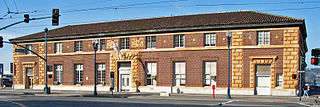
The Ferry Station Post Office Building, also known as the Agriculture Building, is a historic building in San Francisco, California, United States. It was added to the U.S. National Register of Historic Places in 1978.

The Callas Sweet Shop, at 420 Frederica Ave. in Owensboro, Kentucky was built in Beaux Arts style in 1921. It was listed on the National Register of Historic Places in 1986.

























